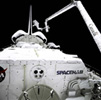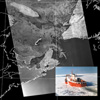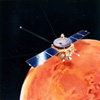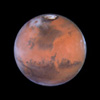Canada's Role
Introduction
The United States plays the lead role in space exploration today. But Canada and other countries contribute, too. In fact, Canada is now an expert in some parts of space missions.
 After the U.S. and Soviet Union, Canada was the third country to have its own artificial satellite in space.
After the U.S. and Soviet Union, Canada was the third country to have its own artificial satellite in space.
Canada provided robot arms for the space shuttle and International Space Station. Thanks to that pioneering work, Canada is now a world leader in space robotics. The country also has its own astronaut team.

|

|
This section will give you a quick overview of Canada's role in space exploration.
Early Days
Canada's role in space exploration goes all the way back to 1839. That's when Sir Edward Sabine set up a magnetic observatory at the University of Toronto. The observatory would be used to study the Northern Lights.
 More recently, satellites have played a key role in Canada's efforts in space. The country's first satellite, Alouette 1, was launched on September 29, 1962.
More recently, satellites have played a key role in Canada's efforts in space. The country's first satellite, Alouette 1, was launched on September 29, 1962.
Alouette 1 was the world's third artificial satellite and marked Canada's entry into the space age. Only the Soviet Union and the U.S. reached space before Canada.
 Alouette 1 studied the ionosphere, an electrically charged part of the upper atmosphere. People could bounce radio signals off the ionosphere, but the Northern Lights interfered with the signals. Scientists hoped to find better ways of sending radio signals over long distances.
Alouette 1 studied the ionosphere, an electrically charged part of the upper atmosphere. People could bounce radio signals off the ionosphere, but the Northern Lights interfered with the signals. Scientists hoped to find better ways of sending radio signals over long distances.
 Their work paid off with the first Anik satellite. "Anik" means "brother" in the Inuit language.
Their work paid off with the first Anik satellite. "Anik" means "brother" in the Inuit language.
Launched in 1972, Anik A1 was a communications satellite. It allowed the nationwide broadcast of live television signals. It also brought reliable telephone service to residents of the Canadian North.
With Anik A1, Canada became the first country in the world to have its own commercial, geostationary satellite communications network.
Canadarm
 It's probably the world's most famous robotic arm, and it was made in Canada. The Canadarm was Canada's first contribution to the U.S. space shuttle program.
It's probably the world's most famous robotic arm, and it was made in Canada. The Canadarm was Canada's first contribution to the U.S. space shuttle program.
 The Canadarm's formal name is the Shuttle Remote Manipulator System. The arm is 15 metres long and weighs 480 kilograms.
The Canadarm's formal name is the Shuttle Remote Manipulator System. The arm is 15 metres long and weighs 480 kilograms.
It's designed like a human arm, but with a few differences. It has nerves of copper wiring, bones of graphite fibre, and muscles of electric motors.
The Canadarm can lift the mass of a fully loaded bus, but it uses less electricity than a teakettle. The arm uses a wire-snare hand to grab objects.
 The first Canadarm was installed on the shuttle Columbia. It was first tested in space in November 1981. Since that successful test, the arm has performed perfectly in dozens of shuttle missions.
The first Canadarm was installed on the shuttle Columbia. It was first tested in space in November 1981. Since that successful test, the arm has performed perfectly in dozens of shuttle missions.
 NASA originally needed a robotic arm that could release and retrieve payloads such as satellites.
NASA originally needed a robotic arm that could release and retrieve payloads such as satellites.
The Canadarm filled that need, but it proved to be useful in many other ways, too. In fact, the Canadarm has been described as "the Swiss army knife of space tools."
Astronauts have used the arm to:
- nudge reluctant satellites into proper orbit
- loosen a jammed solar array
- free clogged waste water drains
- knock ice off the shuttle's waste dump
- act as a mobile platform during spacewalks to repair and upgrade the Hubble Space Telescope
- assist in assembly of the International Space Station
 NASA was so happy with the first Canadarm that it later bought four more for its other space shuttles.
NASA was so happy with the first Canadarm that it later bought four more for its other space shuttles.
The success of the Canadarm made Canada a world leader in space robotics. And it opened the door to Canadarm2, Canada's contribution to the International Space Station.
Learn more about the Canadarm.
Canadian Astronauts
In 1983, the United States invited Canada to fly an astronaut on the space shuttle. In response, Canada formed the Canadian Astronaut Office. The office's goal was to recruit a permanent team of Canadian astronauts to carry out experiments in space.
 That same year, the office invited Canadians to apply to become astronauts. More than 4000 people applied. Just six were chosen. The lucky few were Roberta Bondar, Marc Garneau, Steve MacLean, Ken Money, Bob Thirsk, and Bjarni Tryggvason.
That same year, the office invited Canadians to apply to become astronauts. More than 4000 people applied. Just six were chosen. The lucky few were Roberta Bondar, Marc Garneau, Steve MacLean, Ken Money, Bob Thirsk, and Bjarni Tryggvason.
 In October 1984, Garneau became the first Canadian in space. He worked as a payload specialist aboard the shuttle Challenger.
In October 1984, Garneau became the first Canadian in space. He worked as a payload specialist aboard the shuttle Challenger.
In 1989, the federal government set up the Canadian Space Agency (CSA). Its goal is to lead Canada's efforts in space, and to build and promote the country's space industry. The new agency included the Canadian Astronaut Office.
 In January 1992, Roberta Bondar became the first Canadian woman in space. She worked as a payload specialist aboard the shuttle Discovery.
In January 1992, Roberta Bondar became the first Canadian woman in space. She worked as a payload specialist aboard the shuttle Discovery.
Also that year, the CSA announced that it wanted to recruit four more astronauts. This time, 5000 Canadians applied. Six months later, the agency chose Chris Hadfield, Mike McKay, Julie Payette, and Dave Williams.

|

|

|
 In 1996, astronaut Bob Thirsk took part in an Canadian experiment aboard the shuttle Columbia. The experiment studied why about half of all astronauts suffer from motion sickness while in space.
In 1996, astronaut Bob Thirsk took part in an Canadian experiment aboard the shuttle Columbia. The experiment studied why about half of all astronauts suffer from motion sickness while in space.
Learn more about the experiment.
Dr. Doug Watt of Montreal's McGill University led the study. He found that the astronauts became sick when they moved their heads and bodies in the same direction at the same time. This motion "shuts off" the body's navigation system and leads to nausea.
The International Space Station will allow Canadian astronauts to carry out more experiments and put their other skills to work. Already, astronauts Julie Payette, Marc Garneau, and Chris Hadfield have visited the station. Astronaut Steve MacLean is scheduled to visit the station in 2003.

|

|
Assembly of the station is scheduled to wrap up in 2006. At that point, the CSA plans to send one astronaut to the station for a 3-month stay every 3 years.
 The current Canadian astronaut team includes Hadfield, MacLean, Payette, Thirsk, Tryggvason, and Williams. Bondar and Money left the program in 1992, and McKay left in 1995. Garneau is now the president of the CSA.
The current Canadian astronaut team includes Hadfield, MacLean, Payette, Thirsk, Tryggvason, and Williams. Bondar and Money left the program in 1992, and McKay left in 1995. Garneau is now the president of the CSA.
Only the U.S. and Russia have sent more astronauts into orbit than Canada. By spring 2002, 8 Canadians had flown on 11 separate shuttle missions.
Have a look at the biographies of the Canadian astronauts.
Earth Observation
 Canada is a world leader in making and operating satellites used for observing Earth.
Canada is a world leader in making and operating satellites used for observing Earth.
Canada's first Earth-observation satellite, RADARSAT-1, was launched in 1995. The satellite monitors changes in the environment and allows accurate mapping.
 RADARSAT-1 orbits Earth at 800 kilometres (500 miles) above the planet's surface.
From that height, it can clearly see items as small as 8 metres (26 feet) wide.
That's about the size of the roof of a house.
RADARSAT-1 orbits Earth at 800 kilometres (500 miles) above the planet's surface.
From that height, it can clearly see items as small as 8 metres (26 feet) wide.
That's about the size of the roof of a house.
When it was launched, RADARSAT-1 was the world's most advanced civilian radar satellite.
RADARSAT-1 takes images by bouncing microwaves off the Earth's surface. The magic of radar is that it can "see" in the dark and through clouds and fog.
Images from RADARSAT-1 have been used to:
- monitor the Red River Flood in Manitoba in 1997
- help fishing boats and other vessels to avoid icebergs
- create the first detailed map of Antarctica
International Space Station

Today, Canada is one of 16 countries working together to build the International Space Station. The station is the largest space laboratory in history.
 Canada's main role in the station project is to provide the Mobile Servicing System (MSS). The MSS is a "team" of robots needed to assemble and maintain the station.
Canada's main role in the station project is to provide the Mobile Servicing System (MSS). The MSS is a "team" of robots needed to assemble and maintain the station.
Astronauts will operate the Mobile Servicing System from inside the station. The system will reduce the number of spacewalks the astronauts need to carry out.
The MSS includes:
- a 17-metre (58-foot) long robotic arm called Canadarm2
- the Canada Hand
- the Mobile Base System
Canadarm2
 The Canadarm2's official name is the Space Station Remote Manipulator System (SSRMS). Canadarm2 is similar to the shuttle's Canadarm, but with a few differences. The new arm is larger, heavier, and can handle bigger payloads.
The Canadarm2's official name is the Space Station Remote Manipulator System (SSRMS). Canadarm2 is similar to the shuttle's Canadarm, but with a few differences. The new arm is larger, heavier, and can handle bigger payloads.
Also, Canadarm2 is not permanently attached to the station. Instead, either end (or "hand") of the arm can be used as an anchor point. Meanwhile, the opposite end can perform various tasks.
This design gives Canadarm2 the ability to "inchworm" around the station on its own, "hand over hand." In this way, Canadarm2 can reach much more territory on the station.
 Animation of Canadarm2 moving hand over hand around the International Space Station. NASA animation.
Animation of Canadarm2 moving hand over hand around the International Space Station. NASA animation.
|
In a dramatic mission in April 2001, Canadian astronaut Chris Hadfield helped install Canadarm2 on the station. Hadfield carried out two spacewalks to achieve this goal. He was the first Canadian to leave a spacecraft and float freely in space.

|

|
Canada Hand
 The Canada Hand is a highly advanced robot with two arms that can touch and feel. Its official name is the Special Purpose Dexterous Manipulator (SPDM).
The Canada Hand is a highly advanced robot with two arms that can touch and feel. Its official name is the Special Purpose Dexterous Manipulator (SPDM).
The Canada Hand will be able to handle delicate objects. For example, astronauts will use it to remove or replace batteries, to clean surfaces, and to work on electrical circuits.
The Canada Hand could be launched as early as 2004.
Mobile Base System
 The Mobile Base System (MBS) is a work platform that serves as a base for the Canadarm2 and the Canada Hand.
The Mobile Base System (MBS) is a work platform that serves as a base for the Canadarm2 and the Canada Hand.
The MBS sits on a Mobile Transporter (MT). The transporter is like a railroad car that will move along tracks that run the entire width of the station. In this way, the Canadarm2 or Canada Hand can be moved right across the station.
The MBS was launched and installed on the station in June 2002.
The Future
The next few years will be exciting ones for Canada's space program.
Astronauts and the ISS
Canadian astronauts will continue to visit the International Space Station. They'll help with construction of the station and carry out a wide range of experiments.

|

|
Find out more about Canadian experiments in space.
Earth Observation
 A second Canadian Earth-observation satellite is scheduled for launch in 2003.
Like the earlier RADARSAT-1, RADARSAT-2 will monitor the environment and the
impact of human activities on Earth.
A second Canadian Earth-observation satellite is scheduled for launch in 2003.
Like the earlier RADARSAT-1, RADARSAT-2 will monitor the environment and the
impact of human activities on Earth.
For example, information from the satellite will allow researchers and government agencies to:
- measure the movement of glaciers
- detect oil fields and monitor the spread of oil spills
- study climate change
- monitor clearcut logging
- track illegal fishing boats
RADARSAT-2 will take images more than twice as detailed as images from RADARSAT-1. In fact, RADARSAT-2 will clearly "see" objects as small as 3 metres (10 feet) wide.
Nozomi
 Around the end of 2003, Canadian scientists will be looking to Mars. That's when a Japanese space probe called Nozomi is scheduled to visit the red planet.
Around the end of 2003, Canadian scientists will be looking to Mars. That's when a Japanese space probe called Nozomi is scheduled to visit the red planet.
Nozomi was launched in 1998. It carries a Canadian instrument called the Thermal Plasma Analyzer (TPA). The TPA will measure particles and gases in the Martian atmosphere. Scientists hope to learn about the origin and make-up of the atmosphere.
Mars Lander Missions
"Mars exploration inspires. Exploring Mars may answer the fundamental question:
does life exist or has it existed elsewhere than on Earth? Exploring Mars is the next major international space program after the ISS (International Space Station)."
-- Marc Garneau, Canadian Space Agency president and former astronaut
 Canada hopes to play a key role in several international missions to Mars in the next decade. Two of those proposed unpiloted missions are the Mars Smart Lander and the Mars Sample Return Lander.
Canada hopes to play a key role in several international missions to Mars in the next decade. Two of those proposed unpiloted missions are the Mars Smart Lander and the Mars Sample Return Lander.
 NASA's Mars Smart Lander could launch as early as 2009. The lander will be a roving
science laboratory. It will be "smart" enough to find safe landing spots on the red planet.
NASA's Mars Smart Lander could launch as early as 2009. The lander will be a roving
science laboratory. It will be "smart" enough to find safe landing spots on the red planet.
The mission would help pave the way for the Mars Sample Return Lander mission.
The Canadian Space Agency (CSA) hopes to work on the landing system for the Smart Lander mission. Canada could also provide robotic mining equipment for the lander. The equipment would dig below the surface of the planet so the lander could analyze rock samples.
 The proposed Mars Sample Return Lander mission is even more exciting. This mission could launch as early as 2014.
The proposed Mars Sample Return Lander mission is even more exciting. This mission could launch as early as 2014.
The mission's goal would be to take samples of Martian rock and soil and bring them to Earth. Again, Canada could provide robotic mining equipment for the mission.
Canada has a long history of mining experience. In addition, the country built legs for the Apollo lunar landers and a ramp for the Mars Pathfinder.
And the two Canadarms made Canada a world leader in robotics. So the CSA hopes it can put Canadian know-how to work in these future missions.
View the Canadian space exploration timeline.
*Note: The feature you are reading was produced in May 2002. At that time, the future of some space missions--including the International Space Station and the Mars Sample Return Lander--was uncertain. Some missions have been cut back, delayed, or cancelled due to funding problems. For the latest information on these missions, please visit the following web sites: